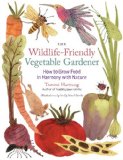
Here’s a book on growing edible crops with a unique perspective, that our vegetable gardens can be planned and designed to encourage or at least coexist peacefully with wildlife. For example, you may not want to share your lettuce with slugs and snails, but you can make the garden hospitable to predators that consume mollusks (such as birds, toads, lizards, foxes, and skunks).
Many of the author’s recommendations are common-sense organic approaches to gardening, such as starting with the soil: respect the microorganisms and other soil-dwelling life forms by not over-tilling and disturbing soil structure; observe nature in your garden (keep a journal or sketchbook) and get to know the insects—beneficial and nuisance—and their life cycles, and the other creatures who visit regularly or seasonally.
Design elements in a wildlife-friendly edible landscape include a “perennial backbone” of fruiting trees and shrubs (fruiting ornamentals that will attract birds and other animals and dissuade them from eating the fruit you’ve planted for your own consumption), a water source, and “decoy plants” planted as a border around plants you intend to harvest for yourself. Some of the ideas here require a fair amount of space: not every urban food gardener has room for a hedgerow, or can afford to plant extra (sacrificial!) rows of crops for hungry critters. Still, you may have room for a few ornamental plants that attract pollinators or a few aromatic shrubs and herbs (like curry plant, Helichrysum italicum, or santolina, or lavender) that may discourage browsing by deer and rabbits.
Deer and rabbits are grazers, so they may not wipe out an entire crop in one fell swoop in the way that gorgers (such as raccoons) or hoarders (like squirrels) can. My own garden has become a favorite spot for these creatures, and they do not even wait for fruit to ripen before absconding with it. I was familiar with many of the “scare tactics” and devices the author suggests, but I had not thought of putting rubber snakes around fruit tree branches to intimidate birds, squirrels, and small rodents, or perching fake owls atop poles to ward off nocturnal foragers.
The book concludes with design plans for edible gardens that are aesthetically pleasing, functional, and inviting for humans as well as other living beings.